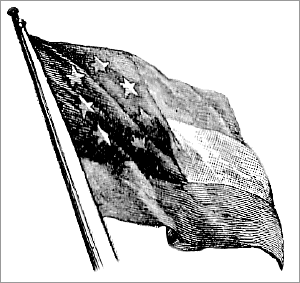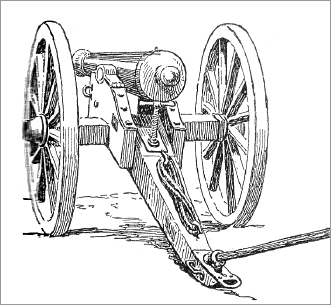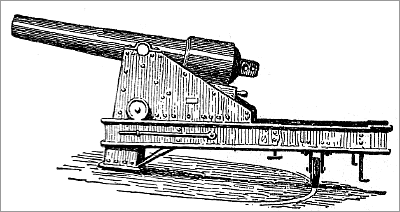| Home > Floripedia > Civil War, Jacksonville | |
Civil War, Jacksonville
A History of Florida1904
Floridians Eager to Enlist. While the events told of in the last chapter were taking place, enlistments were still going on, and regiments were organized to meet calls from the War Department. So eagerly did men enlist that Florida furnished more troops in proportion to her population than did any other State in the Confederacy. Besides the regiments called for by the War Department, there were independent companies and battalions for duty in the State. With the long, unprotected coast line, the work of these forces was very important.
Captain Dickison. Captain Dickison in command of one of these companies did gallant service. His unexpected attacks and successful skirmishes were accomplished with great daring and skill. He was chiefly engaged in East Florida, where his name was "a terror to the foe."

Confederate FlagWhat foothold did the Federals now have? What can be said of Florida's enlistment?
Jacksonville. The Union army had occupied Jacksonville for nearly a month till the spring of 1862, and for a short while in October of the same year. In the early days of March, 1863, Colonels Higginson and Montgomery, in command of two regiments of negro troops, made their headquarters at Jacksonville. General Finegan called upon every man who could to come to assist his little army in driving out these invaders, and on March 10, with all the forces at his command, marched against them. He arranged for his troops to enter the city at different points and engage the Federals at two places at the same time.

Negro SoldiersNegro Troops Routed. After a few rounds the Confederates charged in double quick. The negro troops broke and fled for safety to their gunboats and transports at the wharf. As General Finegan had no means of attacking the vessels, he withdrew his men to a camp beyond reach of the shells thrown from the boats.
Fight at the "Brick Church." On March 17 the Union artillery commenced a cross fire from their intrenchments upon a portion of Major Brevard's battalion at the "Brick Church." The Confederates held their position for about two hours, when the Federals appeared in force. A sharp engagement followed, and the Federals were driven back.
Federals evacuate and burn the City. These engagements were followed by occasional skirmishes, the capturing of pickets, and even the throwing of shots into the Federal camp. The perseverance of the Confederates was at last rewarded, and on Sunday, March 29, the Federals left Jacksonville. Before leaving, however, some of them set fire to a number of wooden buildings, and, as a high wind was blowing, the whole city was soon in flames. It is said that this was done without official sanction.
What of Captain Dickinson's service? Who occupied Jacksonville? What Confederate general planned to expel them?
Salt Works Destroyed. The Confederate government had valuable salt works at St. Andrews Bay, as had also many private persons. As the works were not guarded, the Federals found it an easy matter to destroy them and burn the buildings. The property destroyed by the Federals on St. Andrews Bay was valued at about three million dollars.
Danger from Deserters. During 1863 large numbers of deserters, and other men who wanted to escape serving in the Confederate army, gathered in the woods of middle and western Florida. These men were a cause of terror to the inhabitants. During the latter part of this year, Florida was almost defenseless. The few Confederate troops in the State were so scattered that it seemed impossible for them to oppose a large invading party. The Federal government decided to take advantage of the state of affairs to send an expedition for the purpose of bringing Florida back into the Union, to raise a regiment of white troops as well as negro regiments, and to cut off the supplies that the State was furnishing to the Confederacy.
Tell of the battles at Jacksonville. What was the result? Where were the Confederate salt works? What was the loss in their destruction? What class of men became a menace to the defenseless people at home? How were the troops in the State situated? What did the Federals propose to gain by this condition?
Federal Invasion. On February 7, 1864, the invading force, six thousand men under General Seymour, began their march from Jacksonville to Tallahassee. On the first day's march Camp Finegan was surprised. The Confederates escaped capture, but everything in the camp fell into the hands of the Union army. At Sanderson the Confederates withdrew without giving battle. At Lake City General Finegan was intrenched with a small force, and the Union army, supposing this force to be larger than it was, retreated to Sanderson.

Arms used in Civil WarGeneral Finegan Reenforced. As soon as General Finegan received reenforcements, he moved to Olustee. There he was joined on February 18 by troops from Charleston under General Colquitt and Colonel Harrison The Confederates at Olustee Dow numbered 4,600 infantry and 600 cavalry. They were encamped between Ocean Pond and a cypress pond, and to approach their works the Union army would have to advance over an open field.
When, by what force, and under whom was an invasion made? Tell Of Camp Finegan, Sanderson, and Lake City.
Victory at Olustee. Early on the morning of February 20, the Union army approached in two columns, one by the railroad, the other by the Lake City and Jacksonville road. When the approach was discovered, General Colquitt advanced to the front, and within an hour the whole Confederate force was on the field. The battle lasted more than four hours, and at the end the Union army gave way. General Finegan ordered a pursuit, which was continued until dark.

Arms used in Civil WarResults of the Battle. In this battle the Confederates won a complete victory over a much larger force than their own. The State was saved from invasion, and valuable supplies of cotton, lumber, and provisions were preserved for the Confederacy. Several cannon and 1,600 stand of small arms were captured by the Confederates. They took a very large number of prisoners. The Union loss was 203 killed, 1,152 wounded, 506 missing. The Confederates lost 93 killed, 847 were wounded, and 6 missing.

Arms used in the Civil WarHolding the Federals in Jacksonville. After the hasty retreat from Olustee to Jacksonville, most of the invading party sailed away to South Carolina, but still some Federal troops were at Jacksonville. The Confederates were not strong enough to attack them there, but were determined to prevent them going farther into the interior or into the lower part of the State. A battery was placed a few miles above Jacksonville, and detachments were ordered to prevent injury to the railroads to Cedar Keys and to middle Florida.
What reenforcements were received? What was now the Confederate strength? Where did they prepare for battle? Tell of the battle and its results.
For greater efficiency General Beauregard organized the troops under Anderson into three brigades with Finegan, Colquitt, and Harrison commanding the cavalry into a brigade under Robert H. Anderson, and two batteries under Major G. L. Buist.
What precautions were taken against further invasion?
Source:
Excerpt from Part Two, Chapter 13, "Jacksonville-Olustee" A History of Florida, 1904. Next Section; Table of Contents.
| Home > Floripedia > Civil War, Jacksonville |
Exploring
Florida: A Social Studies Resource for Students and Teachers
Produced by the Florida Center for Instructional
Technology,
College of Education, University of South Florida © 2005.